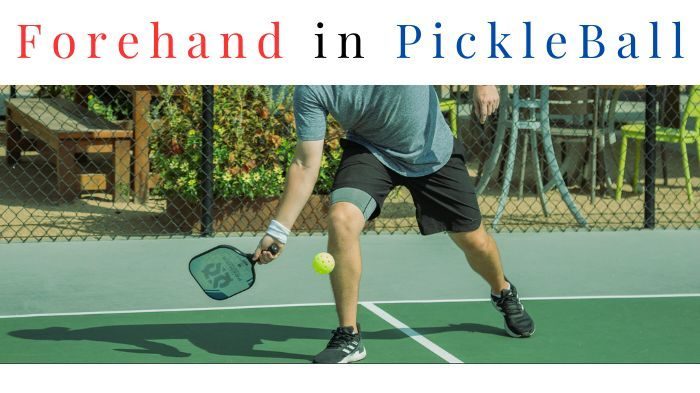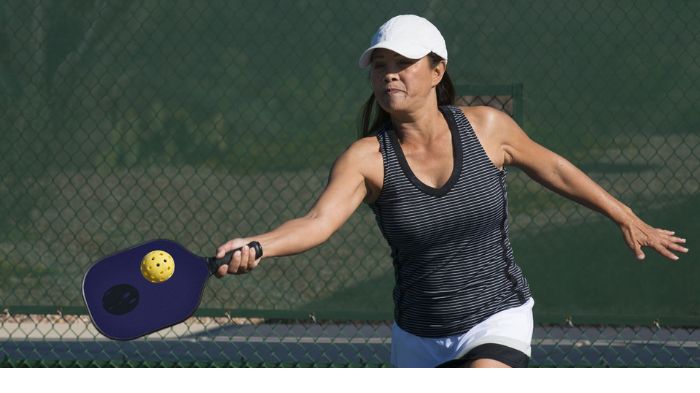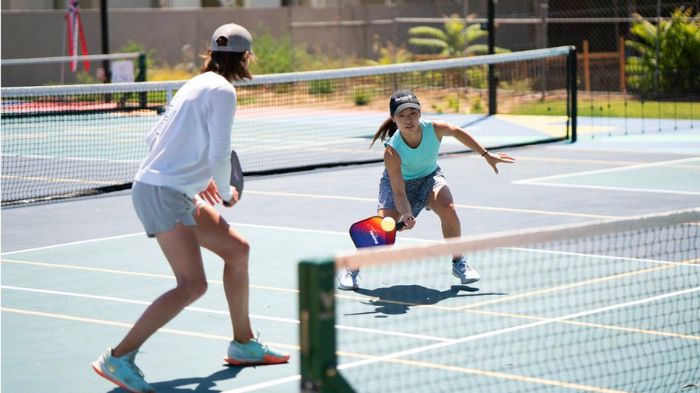Are you a pickleball player or new to pickleball? You may have a query,” What is a forehand in pickleball?” Then, you are at the right place. In this blog, you are going to get an answer to the above question as we are going to describe about forehand in pickleball.
We are now going to discuss how to hit forehand in pickleball and which foot you can use for hitting the forehand pickleball. If you are looking to optimize your pickleball forehand, there are three movements, which we will explain in this blog. Additionally, we are discussing in detail how to hold your pickleball paddle for performing forehand shots.

What Is Forehand Pickleball?
In pickleball, “forehand” refers to a shot where a player uses their stronger hand to strike the ball forward over the net. The forehand shot, which involves hitting the ball with the palm facing the net, holds significant importance in pickleball and is frequently utilized by players. The forehand shot is commonly used when the ball is located on the side of the player’s body where the dominant hand is positioned.
A player can position themself behind the ball and use their weight on their back foot to execute a forehand shot accurately. A continental grip is necessary for performing a forehand shot in pickleball. This grip is similar to a handshake grip but with the index finger extended along the paddle. After positioning themselves correctly, the player swings the paddle forward, hitting the ball in front of their body, and then follows through to complete the shot.
Pickleball players can effectively utilize a well-executed forehand shot as a weapon in both offensive and defensive situations, enabling them to control the ball’s speed and direction during play. We recommend that players practice forehand shots regularly to enhance their technique and increase their chances of success on the pickleball court.
How to Hit a Pickleball Forehand?
To hit a forehand in pickleball, follow these steps:
Get In The Ready Position: Position yourself with your feet spaced apart at the width of your shoulders, and bend your knees slightly. Grasp the paddle using your hands and keep your elbows bent near the torso.
Prepare To Hit The Ball: As the ball approaches, turn your shoulders sideways to the net, bringing your paddle back behind you with your non-dominant hand. Ensure that your dominant hand is holding the grip and prepared to swing forward. Hand signals in pickleball is also so important.
Swing Your Paddle: Swing your paddle forward smoothly, and hit the ball in front of your body. To create a topspin, keep the paddle face slightly unsealed when hitting the ball at a slight angle.
Follow Through: Continue using your paddle after hitting the ball and extend it in the direction of the object you want to reach. Both power and precision will be produced with its assistance.
Recover To The Ready Position: Once you hit the ball, promptly return to your ready position and expect your opponent’s response.
Always maintain visual contact with the ball and engage your entire body to create power, not solely your arm. With dedicated practice, you will soon be executing forehands like an expert. Also, you should learn about ace in pickleball.

Which Foot Can You Use When Hitting a Forehand in Pickleball?
Players in Pickleball typically consider the forehand as the dominant shot and play it using the same foot as their dominant hand. If you are right-handed, you should step forward with your right foot when executing a forehand shot in Pickleball. Similarly, you should step forward with your left foot if you are left-handed.
To execute a forehand shot correctly in Pickleball:
- Grip the paddle using a continental grip, with the back of your hand’s knuckles pointing upward.
- Step forward with your dominant foot while swinging the spike pickleball paddle forward like a hammer.
- Hit the Pickleball in front of your body, around waist height or higher, and move the paddle in the direction you want the ball to go.
In Pickleball, it’s essential to use your entire body when making a forehand shot instead of just using your arm. To produce power and agility while moving around the court in Pickleball, involving your core muscles and using your legs is recommended. Proper footwork and technique will help you hit more consistent, powerful forehand shots in Pickleball.
How Do You Hold a Pickleball Paddle for a Forehand Shot?
For a forehand shot in pickleball, it’s best to use the continental grip. Follow these steps to hold the paddle correctly:
- Start holding the Pickleball paddle for a forehand shot by putting your palm on the handle. Make sure it extends from the tip of your little finger to the back of your index finger, diagonally across your palm.
- After that, wrap your fingers around the paddle’s handle, ensuring a tight grip. Make sure that your index finger points downward towards the paddle’s face.
- Your knuckles, bony protrusions on the back of your hand, should face upward as you turn your wrist inward. It will naturally create a flat face angle, ideal for hitting forehand shots in Pickleball.
- Place your thumb on the paddle’s surface, pointing towards its middle, to complete the grip. Your thumb should be relaxed but not too loose. It will help you have better stability and control when hitting forehand shots.
The continental grip is the most popular grip for hitting forehand shots in Pickleball. It offers a firm and dependable hold, making it easier to hit shots with better accuracy and strength. With regular practice, this grip will feel natural, and you can easily hit forehand shots.
Three Movements to Optimize Your Pickleball Forehand
Lead Hip Internal Rotation
If you’re a right-handed player, being able to rotate your left hip internally is important to execute a standard forehand shot without losing balance. It is important to know where to stand in pickleball, present internal rotation, stand with your feet forward and try to turn your pelvis to the left without moving your feet. Internal rotation refers to the movement that takes place inside your left hip.

In pickleball, the internal rotation of your left hip is necessary for executing a forehand shot. The rotation of your hip significantly contributes to the power and direction of the shot when you step forward to hit the ball. Other body parts also rotate, but the hip’s movement is necessary. If you don’t have enough hip internal rotation and don’t adjust your stroke technique, it can lead to an ineffective forehand shot. Repeating improper techniques over time may result in injury.
Upper And Lower Body Disassociation
The backstroke transition begins with pressure transfer from the trail leg to the lead leg, specifically the right leg for a right-handed player. The lower body initiates this motion while the upper body temporarily holds back. The upper body starts to rotate after that change in the lower body has occurred.
Disassociating your lower body from your upper body is important in pickleball. Without this skill, your stroke may become uncoordinated and ineffective. Observing a toddler attempting to swing a bat or racket demonstrates an example of poor disassociation skills, as they tend to rotate their entire body as a single unit rather than progressively generating forces.
Trail Wrist Extension
The right wrist is considered the trail wrist for a right-handed player. Wrist extension refers to the movement of bending your wrist upwards in the direction opposite to your palm. If you have insufficient wrist extension, your body may need to make up for it in other areas, contributing to the frequent shoulder and elbow injuries seen in the sport.
The wrist needs to extend for a forehand shot, even though the exact position may differ for each shot. It’s worth noting that wrist extension is important in daily activities like driving and standing up from a sitting position.
Frequently Asked Questions
Why Is A Forehand Important In Pickleball?
The forehand shot, which combines power and control, is an essential ability in pickleball because it allows players to set the pace and direction of the match. Additionally, the forehand shot is often used to return serves and is required for both offensive and defensive play. Hence, perfecting the forehand shot through continuous practice and technique improvement will greatly increase a player’s efficacy in gameplay.
What Is A Forehand In Pickleball?
A forehand in pickleball refers to hitting the ball using the paddle on the side of the player’s stronger hand. Right-handed players hit the ball on the right side of their body when executing a forehand shot in pickleball. On the other hand, left-handed players hit the ball on the left side of their body for a forehand shot.
Can A Player Hit A Forehand Shot With Their Non-Dominant Hand In Pickleball?
Yes, a player can perform a forehand shot using their non-dominant hand; however, the effectiveness and comfort level may differ among players.
What Are Some Common Mistakes Players Make When Hitting A Forehand In Pickleball?
Hitting a forehand shot in pickleball can lead to common mistakes, such as using excessive arm movement instead of proper body rotation, failing to position oneself correctly for the shot, and failing to complete the swing with a follow-through.
Conclusion
In pickleball, the forehand is a powerful shot like a pickleball spike that players can utilize to establish opportunities on the opponent’s court. By sharpening your skills in executing this shot, you can transform any game into an exciting backyard turf battle you are ready to dominate. You can optimize your Forehand pickleball by developing the three movements(Lead Hip Internal Rotation, Upper And Lower Body Disassociation, and Trail Wrist Extension).
In this blog post, we have discussed what is a forehand in pickleball(forehand pickleball), how to hit a pickleball forehand, three movements for optimizing your forehand pickleball, etc. Additionally, we have also explained how to hold a pickleball paddle for forehand pickleball shots. We hope you have understood in detail from this blog post regarding the forehand in pickleball, the procedure for hitting a pickleball forehand, etc.



